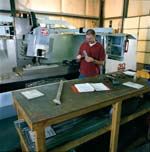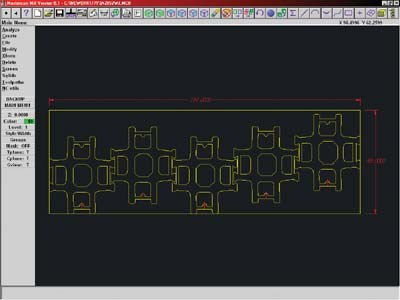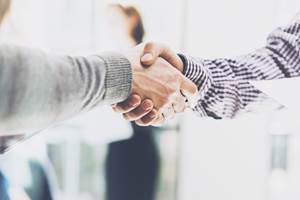Start With Waterjet For More Effective Milling
For aircraft components machined out of plate stock, this shop roughs with abrasive waterjet before finishing with conventional milling. Removing roughing from the machining center cuts cost and lead time.
Share





Part handling contributes to error and lost time. Shops trying to improve how efficiently they machine a given part typically look for ways to reduce the number of setups first.
However, fewer isn’t always better. AFG, or Aerospace Fabrications of Georgia (Dallas, Georgia), recently discovered it could streamline its process for machining aircraft components out of solid aluminum by inserting a setup on an abrasive waterjet machine ahead of the setup on the machining center. The waterjet machine cuts the part to its rough shape so the machining center doesn’t have to. This approach not only saves time, it also results in material savings that reduce the cost of each part.
About The Shop
AFG was incorporated in 1993, the year fresh-out-of-college owner Adam Grizzle first laid hands on CNC equipment and CAD/CAM software in a business environment. Seven years later, in October 2000, AFG became a Bronze Level Certified Supplier to Boeing, placing the company among the top 700 of more than 16,000 Boeing suppliers.
The shop’s start came when a family member loaned Mr. Grizzle the money for his first CNC machine, a used Moog knee mill. Soon the company added another used CNC machine and two very good customers: McCann Aerospace Machining in Atlanta (now AFG’s largest and friendliest competitor) and Aerocell Structures.
A breakthrough for AFG came in 1995. Buyers at Boeing were aware the shop had been subcontracting for McCann, a Boeing supplier. The aerospace giant decided to give AFG the chance to become a direct supplier. Three years later, AFG had the largest part number base of all southeastern Boeing suppliers.
Also in 1995, the shop added a new CNC machining center, a model VF-4 machine from Haas Automation (Oxnard, California). Today the shop has eight three-axis mills, all but one of them from Haas. In 1999, the shop purchased a five-axis machining center from the same company, as well as a waterjet machine from Flow International (Kent, Washington). All of these machines are programmed using Mastercam from CNC Software (Tolland, Connecticut). AFG used this same software to model the first part it aggressively pusued following the purchase of its five-axis machine, an aluminum window frame for the U.S. Air Force/Boeing C-17 cargo plane.
Five-axis machining was a must. The frame conforms not only to the semi-cylindrical curve of the aircraft’s fuselage, but it also must accommodate the fore-to-aft sweep. Even so, the geometry existed only in blueprint form. Though it reached production in the 1990s, the plane was being designed as early as the ’60s. Translating all of its part designs into CAD would not have been cost-effective for Boeing, so Mr. Grizzle worked from the print to create the 3D model of the part to be used for CNC programming.
The frame is machined from 2.5-inch thick 7050-T7651 aluminum plate. While the shop formerly used standard-size plate for this part, it now machines the part out of plate cut to size so it can deliver the part on a JIT basis. When AFG did machine the part from larger stock, nesting the part for waterjet cutting let the shop get five pieces from one plate. Milling alone would allow the same plate to deliver only four pieces. However, even when AFG doesn’t use nesting, Mr. Grizzle says other advantages make waterjet roughing attractive.
Why Waterjet Roughing
“Material handling and fixturing for any waterjet operation is typically more forgiving than for any other CNC machining setup,” Mr. Grizzle says. No fixturing at all was required to cut the window frame out of the large plate on the waterjet because of the mass of the stock. Gravity and friction held the workpiece in place. The 50 hp waterjet cut the rough outline of the part at a rate of 1 inch per minute using 60,000 psi and garnet abrasive. After cleaning, the part was ready for the five-axis machining center.
“If we had done the roughing on the five-axis machine, we’d have added an hour to each piece,” says Mr. Grizzle. Using the machining center alone also would have wasted material, with the material that might otherwise deliver a fifth piece ending up in a pile of chips. “That means the overall material cost per piece would be higher,” he says. “In bidding situations, nested waterjet roughing is part of our competitive edge.”
Other savings from waterjet roughing are not so easy to quantify. “Because of its more hoggish use of materials, conventional roughing won’t allow us the economy to cut an extra piece to have on hand—to build in an ‘oops!’ factor, so to speak—so we can still complete a customer’s order in case of a machining error,” he says. “Also, with waterjet there is a saving in wear and tear on the equipment. We use it not just in aluminum, but also in materials that are hard to rough—even in three-axis applications—to save our CNC mills and cutters. And when compared to five-axis machining, the waterjet is normally less expensive to run, its initial cost being only a fraction of the price of a five-axis mill.”
Waterjet Programming
Most users don’t think of Mastercam as a system for programming waterjets. A waterjet machine usually comes with its own programming system. However, AFG prefers to perform all of its programming off-line, using one system for all of its machines.
“We treat the stream diameter just as we would a small diameter cutter,” Mr. Grizzle says. A 0.040-inch nozzle becomes a 0.040-inch end mill. “Also, we can pierce holes using the software’s drill cycles and cut contours using 2D contour toolpaths. We even incorporated the automatic slowdowns for corners and arcs into the Mastercam post.”
On material up to 1 inch thick, the waterjet machine can give AFG the surface quality it needs for a finish cut, even in titanium. These finish-cut parts in particular argue for programming in the shop’s standard CAM system. One of the reasons the shop chose this software is because the tool paths it generates are associative. When the part model changes, the tool paths change automatically. This is an important advantage to AFG because customers often revise their part files. By using Mastercam for waterjet cutting, the shop extends this same benefit to parts that rely on waterjet for their critical machining passes. Thanks to associativity, when the customer makes a change, the path of a milling cutter or a waterjet nozzle can change along with it.
About the author: David Millson is editorial consultant for CNC Software/Mastercam of Tolland, Connecticut.
Related Content
Arch Cutting Tools Acquires Custom Carbide Cutter Inc.
The acquisition adds Custom Carbide Cutter’s experience with specialty carbide micro tools and high-performance burrs to Arch Cutting Tool’s portfolio.
Read More5 Tips for Running a Profitable Aerospace Shop
Aerospace machining is a demanding and competitive sector of manufacturing, but this shop demonstrates five ways to find aerospace success.
Read MoreHow a Custom ERP System Drives Automation in Large-Format Machining
Part of Major Tool’s 52,000 square-foot building expansion includes the installation of this new Waldrich Coburg Taurus 30 vertical machining center.
Read MoreIncreasing OEM Visibility to Shopfloor Operations for the Win
A former employee of General Motors and Tesla talks about the issues that led to shutdowns on factory lines, and what small- to medium-sized manufacturers can do today to win business from large OEMs.
Read MoreRead Next
Milling With Waterjet
Machine with abrasive waterjet and control the depth of cut. For the right parts, this fledgling process may offer a compelling alternative.
Read MoreBuilding Out a Foundation for Student Machinists
Autodesk and Haas have teamed up to produce an introductory course for students that covers the basics of CAD, CAM and CNC while providing them with a portfolio part.
Read MoreRegistration Now Open for the Precision Machining Technology Show (PMTS) 2025
The precision machining industry’s premier event returns to Cleveland, OH, April 1-3.
Read More.png;maxWidth=970;quality=90)






















.png;maxWidth=300;quality=90)






.jpg;maxWidth=300;quality=90)










.png;maxWidth=970;quality=90)